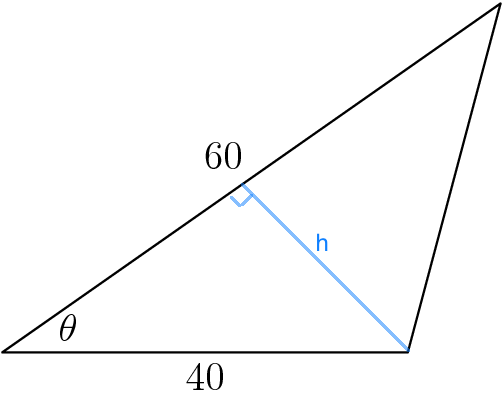\(\begin{array}{} \phantom{=\qquad}\frac{\cos(90°+x)}{\cos(360°-x)\tan(180°-x)\cos(480°)}&\\~\\ =\qquad\frac{-\sin(x)}{\cos(360°-x)\tan(180°-x)\cos(480°)}&\qquad\text{because}\qquad \cos(90°+x)=-\sin (x) \\~\\ =\qquad\frac{-\sin(x)}{\cos(-x)\tan(180°-x)\cos(480°)}&\qquad\text{because}\qquad \cos(360°-x)=\cos(-x+360°)=\cos(-x) \\~\\ =\qquad\frac{-\sin(x)}{\cos(x)\tan(180°-x)\cos(480°)}&\qquad\text{because cos(x) is an even function,}\quad \cos(-x)=\cos(x) \\~\\ =\qquad\frac{-\sin(x)}{\cos(x)(-\tan(x))\cos(480°)}&\qquad\text{because}\qquad \tan(180°-x)=-\tan(x)\\~\\ =\qquad\frac{\sin(x)}{\cos(x)\tan(x)\cos(480°)}&\\~\\ =\qquad\frac{\sin(x)}{\cos(x)\tan(x)\cos(120°)}&\qquad\text{because}\qquad \cos(480°)=\cos(480°-360°)=\cos(120°) \end{array}\)
So far the only difference is because tan(180° - x) = -tan(x)
\(\begin{array}{} \phantom{=\qquad}\frac{\sin(x)}{\cos(x)\tan(x)\cos(120°)}&\\~\\ =\qquad\frac{\sin(x)}{\cos(x)}\cdot\frac{1}{\tan(x)\cos(120°)}&\\~\\ =\qquad\tan(x)\cdot\frac{1}{\tan(x)\cos(120°)}&\qquad\text{because}\qquad \frac{\sin(x)}{\cos(x)}=\tan(x)\\~\\ =\qquad\frac{1}{\cos(120°)}&\\~\\ =\qquad\frac{1}{(-\frac12)}&\qquad\text{because}\qquad \cos(120°)=-\frac12\\~\\ =\qquad-2& \end{array}\)
Check: https://www.wolframalpha.com/input/?i=cos(pi%2F2%2Bx)%2F(cos(2pi-x)tan(pi-x)cos(8pi%2F3))
Part of this last problem is just like the second problem.......
In the diagram below, we know \(\tan\theta=\frac34\) . Find the area of the triangle.
Let the base of the triangle be the side with length 60. Draw a height to that base and call it h .

By the Pythagorean Identity,
| 1+ cot2θ = csc2θ |
|
| 1 + ( 4/3 )2 = 1 / sin2θ |
|
| 25 / 9 = 1 / sin2θ |
|
| 9 / 25 = sin2θ |
|
| sin θ = 3 / 5 |
|
| sin( angle ) = opposite / hypotenuse | |
| sin θ = h / 40 |
|
| 3 / 5 = h / 40 |
|
| 24 = h |
|
| area of triangle = (1/2)(base)(height) | |
| area of triangle = (1/2)(60)(24) |
|
| area of triangle = 720 |
|